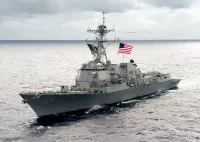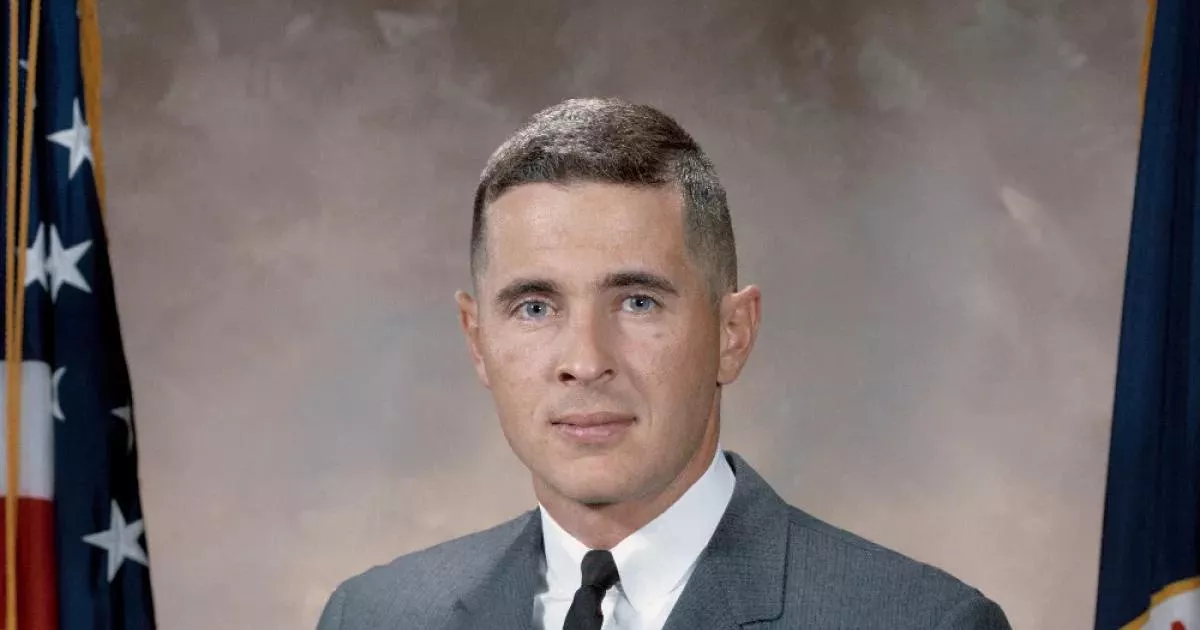William Alison Anders is a retired American astronaut, engineer, and businessman known for his role in the Apollo 8 mission. As part of this mission in December 1968, he, along with Frank Borman and Jim Lovell, became the first humans to orbit the Moon. Anders captured the iconic "Earthrise" photograph during this mission. Beyond his space exploration, he served as a Major General in the US Air Force and held positions in engineering and business.
1927: Arthur Anders Graduates from the Naval Academy
William Anders's father, Arthur Anders, graduated from the United States Naval Academy in 1927.
June 1937: Escape from China During the Second Sino-Japanese War
In June 1937, the Second Sino-Japanese War began, forcing Anders and his mother to flee Nanjing, China, due to the Japanese invasion.
1951: Graduation from Boyden School
William Anders graduated from the Boyden School, a military academy prep school in San Diego, in 1951.
1955: Marriage to Valerie Hoard
After graduating from the Naval Academy in 1955, William Anders married Valerie Elizabeth Hoard.
1955: Graduation from the United States Naval Academy and Commission into the Air Force
In 1955, William Anders graduated from the United States Naval Academy in Annapolis, Maryland, and was commissioned as a second lieutenant in the United States Air Force.
1956: Becoming a Fighter Pilot
Upon receiving his pilot wings in 1956, Anders became a fighter pilot, flying Northrop F-89 Scorpions equipped with nuclear-tipped air-to-air missiles.
1957: Birth of Alan Anders
William and Valerie Anders welcomed their first child, Alan, in 1957.
1958: Birth of Glen Anders
Glen Anders, the second child of William and Valerie Anders, was born in 1958.
1960: Birth of Gayle Anders
Gayle Anders, the daughter of William and Valerie Anders, was born in 1960.
1962: Assignment to the Air Force Weapons Laboratory
After graduating with his master's degree in 1962, Anders was assigned to the Air Force Weapons Laboratory at Kirtland Air Force Base, where he oversaw the technical aspects of nuclear power reactor programs.
1962: Birth of Gregory Anders
Gregory Anders, the fourth child of William and Valerie, was born in 1962.
1962: Master's Degree in Nuclear Engineering
William Anders earned a Master of Science degree in nuclear engineering from the Air Force Institute of Technology in 1962.
June 1963: NASA Astronaut Selection
In June 1963, NASA announced its search for new astronauts for Projects Gemini and Apollo, prompting William Anders to apply.
October 1963: Acceptance into NASA Astronaut Program
On his birthday, October 17, 1963, William Anders was informed of his acceptance into NASA's astronaut program as part of the third group.
1964: Birth of Eric Anders
In 1964, William and Valerie Anders had their fifth child, Eric.
September 1966: Backup Pilot for Gemini 11 and Lunar Landing Training Vehicle Training
In September 1966, Anders served as backup pilot for the Gemini 11 mission. He and Neil Armstrong, the backup commander, also became the first astronauts to train on the Lunar Landing Training Vehicle.
December 1966: Assignment to Apollo Mission
In December 1966, Anders was assigned to the third Apollo mission as the lunar module pilot.
June 1968: Delays and Defects in Lunar Module
The arrival of the lunar module at Kennedy Space Center in June 1968 revealed over a hundred significant defects, causing delays in the mission.
July 1968: Crew Change for Apollo Mission
Michael Collins, originally the command module pilot for Anders' Apollo mission, was replaced by Jim Lovell in July 1968 due to a medical issue.
August 1968: Soviet Lunar Mission Threat
Reports emerged in August 1968, including one from the CIA, suggesting the Soviet Union planned a crewed lunar orbit mission by year's end.
December 1968: Apollo 8 Mission and the First "Earthrise" Witness
Anders, as part of the Apollo 8 mission in December 1968, became one of the first humans to travel beyond low Earth orbit and orbit the Moon. The crew witnessed and photographed an "Earthrise" for the first time in human history.
December 1968: Apollo 8 Mission
In December 1968, William Anders embarked on the historic Apollo 8 mission, becoming one of the first three humans to orbit the Moon and capturing the iconic "Earthrise" photograph.
May 1969: Nomination as Executive Secretary of NASC
President Richard M. Nixon nominated Anders to be the executive secretary of the National Aeronautics and Space Council (NASC) in May 1969, the highest government post offered to an astronaut at that time.
1969: Executive Secretary of the National Aeronautics and Space Council
From 1969 to 1973, William Anders served as the executive secretary of the National Aeronautics and Space Council.
1972: Anders Recommends Abolition of NASC
Anders, increasingly pessimistic about the future of the NASC and the space program, recommended its abolition in 1972.
1972: Birth of Diana Anders
Diana Anders, the sixth child of William and Valerie, was born in 1972.
June 1973: Abolition of the NASC
Anders' recommendation to abolish the NASC due to its lack of influence was implemented on June 30, 1973.
August 1973: Appointment to the Atomic Energy Commission
President Nixon appointed Anders to the Atomic Energy Commission (AEC) in August 1973, seeking an engineer's perspective on the commission.
1973: Atomic Energy Commission Commissioner
Anders was appointed as a commissioner of the Atomic Energy Commission in 1973, a position he held until 1975.
January 1975: Appointment as Chairman of the Nuclear Regulatory Commission
With the AEC split in January 1975, Anders became the first chairman of the newly formed Nuclear Regulatory Commission (NRC).
1975: Chairman of the Nuclear Regulatory Commission
In 1975, Anders became the chairman of the Nuclear Regulatory Commission, serving until 1976.
April 1976: Appointment as Ambassador to Norway
Anders was appointed as the U.S. Ambassador to Norway in April 1976.
1976: Ambassador to Norway
William Anders served as the Ambassador to Norway from 1976 to 1977.
June 1977: End of Term as Ambassador to Norway
Anders' term as the U.S. Ambassador to Norway ended in June 1977.
September 1977: Joining General Electric
Anders joined General Electric in September 1977 as vice president and general manager of its Nuclear Products Division.
August 1979: Harvard Business School Advanced Management Program
In August 1979, Anders attended the six-week Advanced Management Program at Harvard Business School.
January 1980: General Manager of GE Aircraft Equipment Division
Anders became the general manager of GE's Aircraft Equipment Division in January 1980.
1980: General Manager of GE Aircraft Equipment Division
In 1980, Anders transitioned to the role of general manager of the GE Aircraft Equipment Division.
1983: William Anders Inducted into International Space Hall of Fame
In 1983, William Anders was inducted into the International Space Hall of Fame, recognizing his significant contributions to space exploration.
1984: William Anders Joins Textron
In 1984, William Anders left General Electric to become the executive vice president for aerospace at Textron. This move marked a significant shift in his career from GE to Textron. During his tenure, he got to fly Bell helicopters as Bell was a subsidiary of Textron.
1988: Retirement from the Air Force Reserve
William Anders retired from the Air Force Reserve with the rank of major general in 1988.
1988: William Anders Retires from Air Force Reserves
William Anders retired from the Air Force Reserves as a major general in 1988. Throughout his civil service, he maintained his active flight status, flying NASA Northrop T-38 Talon aircraft and helicopters.
1990: Vice Chairman of General Dynamics
In 1990, Anders assumed the position of vice chairman of General Dynamics.
1990: William Anders Becomes Vice Chairman of General Dynamics
In 1990, William Anders was appointed vice chairman of General Dynamics, marking another significant step in his corporate career.
1990: William Anders Inducted into International Air & Space Hall of Fame
In 1990, William Anders was honored with an induction into the International Air & Space Hall of Fame, acknowledging his achievements in aerospace.
January 1991: Chairman and CEO of General Dynamics
In January 1991, Anders took on the roles of chairman and CEO of General Dynamics.
January 1991: William Anders Appointed Chairman and CEO of General Dynamics
On 1 January 1991, William Anders became the chairman and CEO of General Dynamics. He undertook significant restructuring, including moving the headquarters to Virginia, negotiating settlements, and reducing staff.
1993: Retirement as CEO of General Dynamics
Anders retired as CEO of General Dynamics in 1993.
1993: William Anders Retires as CEO of General Dynamics
William Anders retired as the CEO of General Dynamics in 1993. During his tenure, he significantly reduced the company's debt and increased shareholder value.
May 1994: William Anders Retires as Chairman of General Dynamics
In May 1994, William Anders retired as the chairman of General Dynamics, marking the end of his significant contributions to the company.
May 1994: Retirement from General Dynamics
William Anders retired as chairman of General Dynamics in May 1994.
1996: William Anders Establishes Heritage Flight Museum
In 1996, William Anders founded the Heritage Flight Museum in Bellingham, Washington. The museum, dedicated to preserving aviation history, is run by the Anders family.
1997: William Anders Inducted into U.S. Astronaut Hall of Fame
William Anders was inducted into the U.S. Astronaut Hall of Fame in 1997, celebrating his accomplishments as an astronaut.
2004: William Anders Inducted into National Aviation Hall of Fame
In 2004, William Anders was inducted into the National Aviation Hall of Fame, further solidifying his legacy in the field of aviation.
2005: William Anders Appears in PBS Documentary
William Anders appeared as himself in the 2005 PBS documentary Race to the Moon, part of the American Experience series, highlighting the Apollo 8 mission.
2008: William Anders Ends Tenure as President of Heritage Flight Museum
William Anders served as the president of the Heritage Flight Museum until 2008, overseeing its operations and ensuring its growth and success.
2013: PBS Documentary Renamed Earthrise: The First Lunar Voyage
The PBS documentary Race to the Moon, featuring William Anders, was renamed Earthrise: The First Lunar Voyage in 2013. The film covered the events leading up to the Apollo 8 mission.
2014: Heritage Flight Museum Relocates
In 2014, the Heritage Flight Museum, founded by William Anders, relocated from Bellingham to Skagit Regional Airport in Burlington, Washington.
2015: William Anders Interviewed in No More Worlds to Conquer
In 2015, William Anders was interviewed for a chapter in Chris Wright's book No More Worlds to Conquer, which detailed his life in the Apollo program and his later corporate career.
January 2021: Public Domain Material on William Anders Retrieved
Public domain material on William Anders was retrieved from NASA on 8 January 2021, offering detailed insights into his life and career.
June 2024: William Anders Passes Away
William Anders died on 7 June 2024, at the age of 90, in a plane crash between Jones Island and Orcas Island. His son, Lt. Col. Greg Anders, confirmed that the crash occurred while his father was flying a T-34 aircraft owned by the Heritage Flight Museum.
June 2024: Death of William Anders
William Anders tragically passed away in June 2024 when his vintage Beechcraft T-34 Mentor crashed into Puget Sound.
Mentioned in this timeline
Home Box Office HBO is an American pay television service...
The Union of Soviet Socialist Republics USSR existed from to...

The Second Sino-Japanese War fought between China and Japan from...
Hong Kong is a Special Administrative Region of the People's...
NASA the National Aeronautics and Space Administration is an independent...
China officially the People's Republic of China PRC is an...
Trending
Cristela Alonzo is an accomplished American stand-up comedian actress writer and producer She made history as the first Mexican American...
26 days ago Marcus Freeman: Notre Dame coach considered for Giants head coaching vacancy in NFL.
2 months ago ACA Subsidies Expiration Fuels Premium Fears Amid Government Shutdown, Impacting Covered California

1 month ago Cam Newton Reacts to Drake Maye's Taunt; Patriots Champ Rips Newton's Criticism.

2 months ago Upstart's Q3 Earnings: Mixed Results, Soft Q4 Guidance, and Stock Slides After Announcement.
2 months ago Great Salt Lake Dust Cost Revealed; Ogden Canyon Restaurant Set to Reopen.
Popular

Stranger Things created by the Duffer Brothers is a popular...

XXXTentacion born Jahseh Dwayne Ricardo Onfroy was a controversial yet...
The Kennedy Center Honors are annual awards recognizing individuals and...
Turning Point USA TPUSA is an American nonprofit organization founded...

Bernie Sanders is a prominent American politician currently serving as...

Candace Owens is an American conservative political commentator and author...
